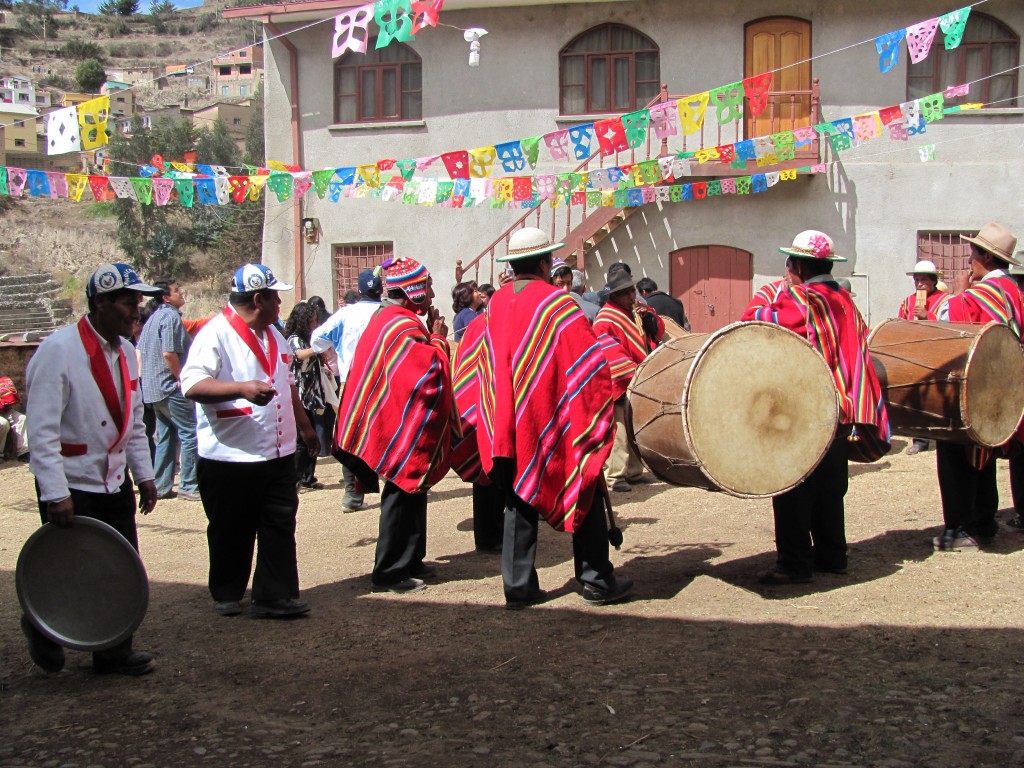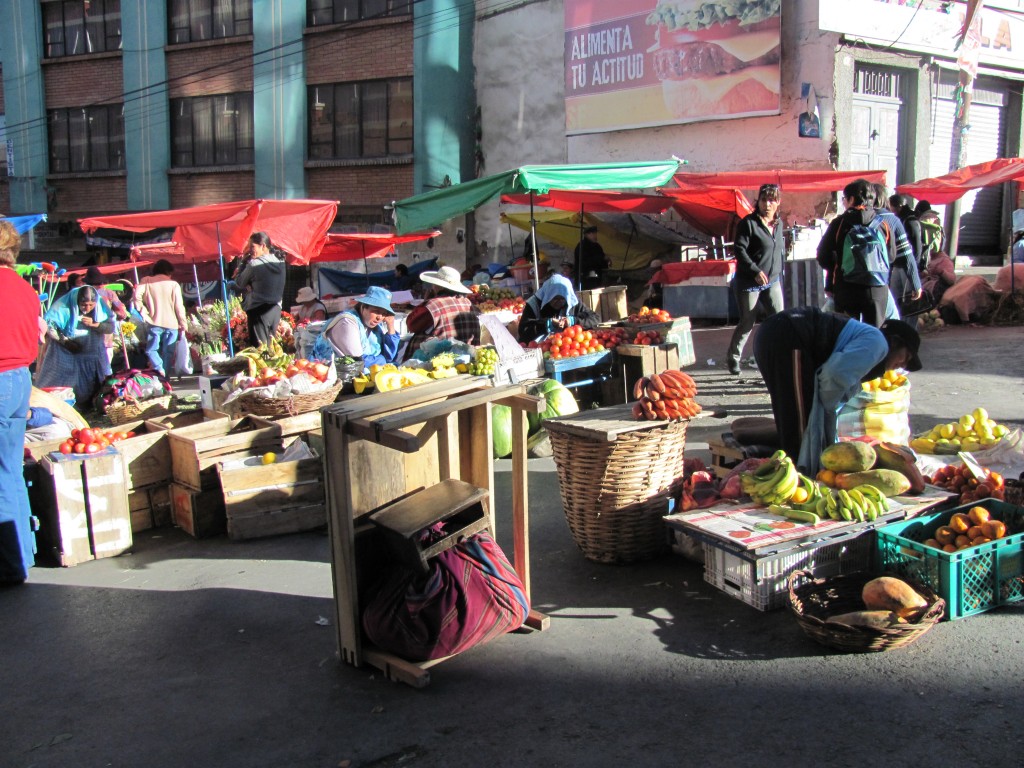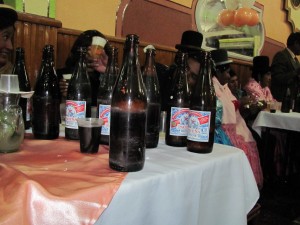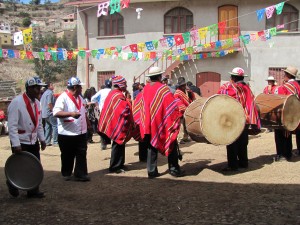So, what have I learned about medical anthropology in Bolivia?
A lot, although I’ve only begun scratching the surface of all these topics. For a med-anth dork like myself, this is a great situation- it seems like every day, some new potential research topic reveals itself to me. The excitement of discovering interesting local issues to explore feels all the more intense because for the most part, these are questions I can’t just research in the library. There has been a surprisingly small amount of research in medical anthropology in Bolivia. Apart from a few classic texts, like those by Joseph Bastien and Libbet Crandon-Malamud, there has been only the occasional scholar who has published about medical issues here in the past few decades. This creates in me a feeling of immediacy- the sense that I really could, and should, run off to investigate all of these issues as soon as possible.
Before I discuss the findings that relate to my original research plan, here, as a sampling, are some of the other questions which caught my attention this past summer.
Future Research Project # 1: Sexuality and contraception in Bolivia’s fastest-growing city
In one of my first weeks in Bolivia, I was having dinner with some more seasoned anthropologists. None of them worked on medical issues; archaeology and politics seem to see the most scholarly work in Bolivia at the moment. But upon hearing of my interest in gender and sexuality research, one of the women present suddenly remembered something a friend and informant had mentioned to her. “Apparently, young women are using all sorts of secretive means to control their fertility lately,” my archaeologist friend told me. The young woman who had shared this with her was from El Alto, the nearly all-indigenous city located just over La Paz, which is the fastest-growing city in Bolivia due to the high migration of Aymara people from the countryside. Although Aymara tradition encourages large families, these younger women living in the cities are seeing whole new worlds of economic opportunity opening up for them- a chance to acquire some wealth, if they didn’t have 6 or 8 children to provide for. So, sometimes with, and sometimes without, the collusion of their husbands, young women are commonly sneaking birth control and obtaining illegal abortions.
The striking thing to me was that, as this researcher recounted the story, the others who were present realized that they had heard similar reports, told in hushed tones by young women they knew in El Alto. I found everything about this situation fascinating. Not only were there the straightforward factual questions to investigate- Who are these women? How widespread is the phenomenon? Where and how are they accessing these birth control services?- but her description also underscored the reality of rapidly changing values regarding family roles, economic possibilities, and Aymara traditions. Furthermore, there is something of a lacuna regarding knowledge of Aymara sexuality in anthropological research. Aymara culture is generally known as a conservative, hard-working and closed-mouth culture, whose people are not forthcoming on issues of sex. Such mores, though, may be loosening under the influences of migration and urbanization.
Future Research Project #2: Alcohol, alcoholism, and gender
I was at a wedding in El Alto, the guest of my friend A., an anthropologist who has worked in Bolivia for many years. I had been forewarned about expectations regarding alcohol at events such as this. “You’re not really able to say no when you are given alcohol,” she told me. “There’s just no polite way to do it. You just have to prepare to be really, really sick tomorrow.”
Bolivians drink. And I say this as a girl who likes a good party, and who admirably met society’s expectations for teenage/college shenanigans: You can tag me out in the first hour of a Bolivian party, whereas they will continue on happily for another 16 (and then wake up and do it all again after a few hours of rest).
Here’s how it goes, as typified by this one wedding (which turned out to be not even close to the wildest celebrating I witnessed). It is polite to contribute a case of your own booze, since each person will consume at least this much. (Sadly for me as a beer-hater, the preferred beverages are beer, endless beer; singani, a type of liquor made from grapes; and chicha, a nauseating corn-based brew.) The social interaction of the entire event is a nonstop repetition of the following encounter: I pour you a (4-oz or so) plastic cup of beer. You spill a drop or two on the ground, as an offering to Pachamama (mother earth), toast me, and then down the entire cup in one gulp. Then, you fill my cup. I gulp it down in similar fashion. We rotate to the next person and repeat. It’s kind of like speed dating, except you chug instead of chat. As you might imagine, this is an effective way of getting inebriated, and within an hour you have people dancing, spontaneously falling over, and prone to egregious displays of what A. and I dubbed the “I love you, man.”
What separates Bolivian drinking from other types of revelry I have known is the amount consumed and the sheer endurance of the drinkers. Alcohol is not simply a social lubricant here, it is the 200 HP engine that powers the social scene. People will drink far past what I used to assume would be the point of alcohol poisoning, and they will continue this for days during a celebration: waking up early to start drinking and continuing into the wee hours of the night. And the celebrations are innumerable. In addition to weddings, baptisms, birthdays and the like, there are national and local holidays that provide near-weekly entertainment.
I have always been fascinated by cultural ideas about alcohol consumption and whether a culture possesses an idea of alcohol-ism. Here in Bolivia, I asked many people about this topic. Most people told me that the idea of having a “problem” with alcohol is not very widespread, in contrast to the disease model of alcoholism that is prevalent in neighboring South American countries and, of course, the U.S. If this is the case, I would like to find out more about how problems related to drinking are understood in Bolivia, because there seems to be incontrovertible evidence of- if not problems- issues related to alcohol. It is not uncommon to find men passed out in the street at any hour of the day, flat on their backs on the sidewalk. It’s also commonly discussed how men’s episodes of drunkenness correspond to beating their wives, which occurs with alarming frequency. There is, in general, a distinct gendered dimension to this issue, with the norms for male drinking entirely different from female drinking. In my mind, all of these questions deserve further inquiry.
Potential Research Project #3: Kallawayas: The end of a generation?
The Bolivian Andes possess their own mythical medicine men, called Kallawayas. Kallawayas are traveling healers, easily recognizable by the colorful pouches and medicine bags slung over their shoulders, who are said to have been the healers of the Inca kings. They possess extensive herbal knowledge, and perform divinatory and magical rituals for patients. They primarily speak Quechua (the other dominant language and ethnic group in Bolivia), but as healers also speak a secret language for the transmission of medical knowledge, which uses a vocabulary believed to descend from the now-extinct Puquina language.
The town of Charazani is known as the home of Kallawaya healers, and I visited this town over the summer. It is a beautiful, remote place, a small town of about 600 people nestled into the hills between two mountain ranges. Like every other town in Bolivia, they celebrate their annual town anniversary with a huge celebration, a giant 4-day orgy of drinking (see research project #2) and music, in this case provided with traditional pan-flutes and drums. At the time I decided to visit, I didn’t understand how fully this party would dominate life in Charazani over the entire weekend, but let’s just say it didn’t turn out to be the best time for gathering information on native healing practices. Still, by the end of the weekend I’d met some local families whose stories promised a wealth of anthropological riches I could potentially explore at a later time.
“You’re an anthropologist? This is beyond wonderful,” exclaimed Carlos in delight. Carlos, a Charazani native I’d met in the town square one day, was from an old local family, although not typical of Charazani, as he had attended Tulane and now lived in Miami. He, along with some friends and family, had been hoping to set up a project to record the stories of some of the very old Kallawaya healers in the area. “There is a whole generation of Kallawayas that is close to dying,” he explained earnestly, “and we don’t know how much of the knowledge will be preserved in future generations. We are hoping to capture as many of their stories as we can.”
Like most medical anthropologists, I imagine, I have a soft spot for learning about classic “traditional” medicine- ethnobotany, shamanism, what foods are prepared for what ailments, etc. The idea of collecting narratives from the famous healers of the Andes holds no small allure for me. I spent the day-long bumpy ride back to La Paz fantasizing about traipsing across the altiplano, traveling from one small village to the next (with a Quechua research assistant to translate) collecting life stories from wizened elder men as we sat drinking coca tea. But, I have other research questions in mind to be tackled, and over the summer, I think I have found an approach that examines both traditional medicine and modern city living….
Actual Research Problem #1: Sobreparto, a chronic and mysterious reproductive illness of the Andes
Over the course of the summer, I was fortunate to meet Carmen Beatriz Loza, a researcher of Bolivian history and medicine. Her partner is Walter Alvarez, who is both a Kallawaya healer and a biomedical doctor who went to medical school in Cuba. (The close ties between the Cuban health system and Bolivia, a newly socialist country, are Future Research Project Number 4, by the way. It’s a complex and intriguing relationship. Currently, there are a fair number of Cuban medical practitioners who practice in underserved areas of Bolivia, and Cuba operates scholarship programs to send poor indigenous students to medical school in Cuba.) Walter practices both traditional medicine and biomedicine in El Alto, and together with Carmen, formed a small research institute called the Bolivian Institute for Traditional Kallawaya Medicine. Here Walter and Carmen study, teach, and share traditional medical knowledge with their community, as well as research particular medical issues.
One such issue I learned about from Carmen is an illness called sobreparto. Sobreparto literally means “after birth,” and it refers to a type of illness that is known in many Latin American countries, but which has no biomedical counterpart. The illness can begin any time after birth, from the first weeks postpartum to years after birth. It is related to the belief that women are particularly weak and susceptible to sickness and spirit possession after their body has been “opened” by childbirth. Common attributions for the disease include heat or cold entering the body; evil spirits entering the body; and overwork or ill-treatment of the woman after the birth, when she is supposed to be resting and cared for by family. Ill treatment, such as physical or mental violence or neglect, by a husband is also cited as a cause of sobreparto.
Because my research centers on the topic of chronic pain, and whether emotional and interpersonal factors are understood to impact physical health, sobreparto is a fascinating case study. It is a common condition, respected and feared by Andean men and women. Its onset and course are highly variable, but the disease is often chronic. The symptomatology is also highly variable; sobreparto can include everything from skin rashes to persistent hot and cold feelings to stomach pains. It also appears tightly intertwined with local expectations of women and their work. Andean women generally lead difficult lives, in terms of both back-breaking labor and the perpetual cycle of pregnancy, birth and lactation they are in for most of their adult lives. But, as the case of sobreparto hints, it appears understood that there are moments when this stress can be too much.
Thus, I look forward to investigating this topic further as part of my dissertation research. There is a large project beginning at the Institute that I have been invited to collaborate on, which will utilize their connections to local networks of healers in order to investigate traditional ways of understanding and treating sobreparto. Walter’s clinical work and local patient base would provide access to sobreparto patients whom I could interview about their own experiences with the illness. It seems like a project that would integrate my interest in the concepts of traditional medicine with my interest in the changing, dynamic urban setting of El Alto.
This means my other potential research projects may have to be put on the back burner for now…. but from what I hear, it’s good to have future projects to think about when one is slogging through the tougher moments of a dissertation project. I’m certainly lucky to have an abundance of those to daydream about.
Abbe Rose Kopra is a doctoral student at the University of Chicago, studying medical and psychological anthropology in the interdisciplinary Department of Comparative Human Development. Her research focuses on the problem of chronic pain; she is interested in cultural interpretations and attributions for chronic pain, how individuals cope psychologically with chronic pain, and the connection between the two. She is currently spending the summer in the Bolivian Andes, studying the language of Aymara and doing preliminary research for her dissertation fieldwork next year. This is her first summer in her chosen field site, and here she reflects about different aspects of the experience in a series of essays for Anthropology Now’s ‘Fieldnotes’ category.







One Response
It sounds like you have found some extremely interesting research topics to pursue in Bolivia! I have enjoyed reading your posts and I look forward to seeing which direction you choose to go in!